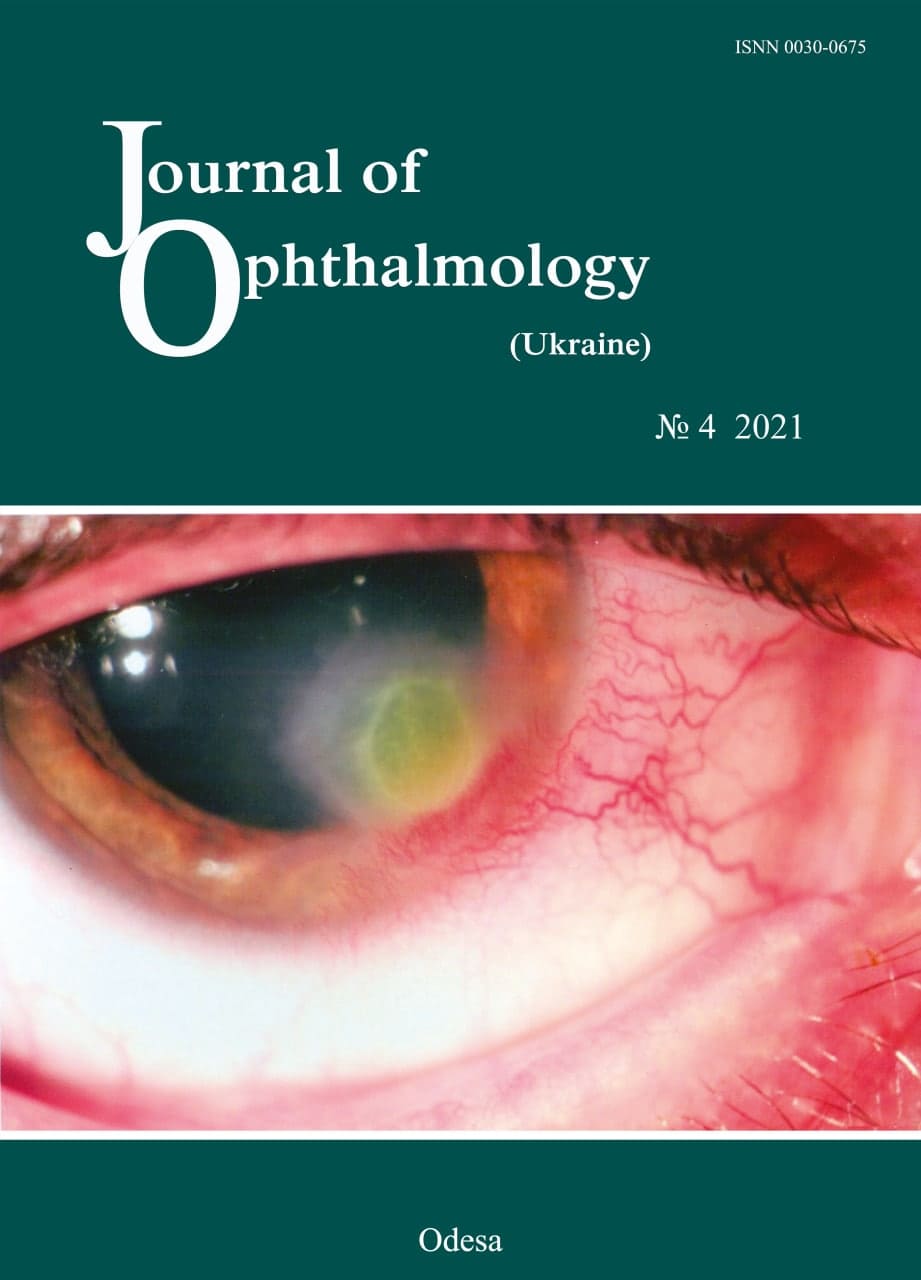Prediction of the progression of diabetic retinopathy based on hemodynamic data
DOI:
https://doi.org/10.31288/oftalmolzh202142631Keywords:
disease prognosis, diabetic retinopathy, peak systolic velocity, resistivity index, diabetic retinopathy severity, progression risk indexAbstract
Background. Diabetic retinopathy (DR) is a vascular complication of diabetes, leading to vision loss and blindness in people of any age. This highlights the need for monitoring and predicting the course of DR to start early timely treatment and to prevent progression to the proliferative stages of the disease.
Purpose. To study the features of ocular hemodynamics and develop the progression risk index for DR.
Material and Methods. One hundred and sixty-five patients with non-proliferative diabetic retinopathy (NPDR) were randomly allocated to receive traditional treatment (control group), daily tablets of Tanakan (TT group), or daily endonasal electrophoresis of Tanakan (TE group) within ten days. The stages of DR were determined using the severity scale of the Early Treatment Diabetic Retinopathy Study (ETDRS). The main outcome measures were changes in DR severity (DRS), Doppler ultrasound imaging at months 1, 3, and 6.
Results. Moderate negative correlations were found between peak systolic velocity (PSV) of the central retinal artery (CRA) and DRS, end-diastolic velocity (EDV) of CRA and DRS, PSV of central retinal vein (CRV) and DRS, PSV of the short posterior ciliary artery (SPCA) and DRS. Developed diabetic retinopathy progression risk index (DRPRI) was less than 1,0 in the TE group that enabled us to predict DR stability or improvement.
Conclusions. This validation study demonstrated that PSV and DRS are correlated, and PSV can be used to diagnose the stages of DR. Developed DRPRI can be used to assess the effectiveness of treatment and to predict DR, which is essential for determining further patient management tactics.
References
1.International Diabetes Federation. IDF Diabetes Atlas, 9th edn. Brussels, Belgium: 2019. Available at: https://www.diabetesatlas.org
2.Pasyechnikova N., Moroz O. Study on the effect of quercetine and lipoate on lipid peroxidation in the retina in experimental diabetes. Oftalmologicheskii Zhurnal, 2016;(4):38-42. https://doi.org/10.31288/oftalmolzh201643842
3.Kusuhara S, Fukushima Y, Ogura S, Inoue N, Uemura A. Pathophysiology of Diabetic Retinopathy: The Old and the New. Diabetes Metab J. 2018;42:364-376.https://doi.org/10.4093/dmj.2018.0182
4.Alekseev IB, Kochergin SA, Vorob'eva IV, Mikhaleva LG. On some pathogenic features of diabetic retinopathy in type II diabetes mellitus and the role of antioxidants and ginkgo biloba. Vestn Oftalmol. 2013; (3):89-93.
5.Kangilbaeva G, Jurabekova A. Effect of EGb 761 (Tanakan) Therapy in Eyes with Nonproliferative Diabetic Retinopathy. International Journal of Pharmaceutical Research. Jul - Dec 2020. Vol 12. Supplementary Issue 2, P. 3019-3023.https://doi.org/10.31838/ijpr/2020.SP2.317
6.McKeage K, Lyseng-Williamson KA. Ginkgo biloba extract EGb 761® in the symptomatic treatment of mild-to-moderate dementia: a profile of its use. Drugs Ther Perspect. 2018;34(8):358-366.https://doi.org/10.1007/s40267-018-0537-8
7.Aznabaev BM, Gabdrahmanova AF, Muhamadeev TR, Gallyamova GR, Alexandrov AA. Ophthalmoneuroprotection in nonproliferative diabetic retinopathy and eye hemodynamics. RMJ Clinic ophthalmology. 2014; (2): 71-75.
8.Bakhritdinova F, Kangilbaeva G, Mirrakhimova S, Jurabekova A. Development of dopplerographic criteria for the progression and prognosis of diabetic retinopathy. European science review 2018;1-2:113-117.
9.Blum M, Eichhorn M, Vilser W. Haemodynamics and Diabetic Retinopathy. Klin. Augenheilk. 2005; 222(6):463-470.https://doi.org/10.1055/s-2005-858422
10.Divya K, Kanagaraju V, Devanand B, Jeevamala C, Raghuram A, Sundar D. Evaluation of retrobulbar circulation in type 2 diabetic patients using color Doppler imaging. Indian J Ophthalmology. 2020;68:1108-1114.https://doi.org/10.4103/ijo.IJO_1398_19
11.J Fernando Arevalo. Classification of diabetic retinopathy and diabetic macular edema. World Journal of Diabetes. 2013; 4(6):290-294.https://doi.org/10.4239/wjd.v4.i6.290
12.JK, Wang PW, Taylor S, Haskova Z. Durability of Diabetic Retinopathy Improvement with As-Needed Ranibizumab: Open-Label Extension of RIDE and RISE Studies. Ophthalmology. 2019;126(5):712-720.https://doi.org/10.1016/j.ophtha.2018.10.041
13.Fong DS, Aiello L, Gardner TW, King GL, Blankenship G, Cavallerano JD, et al. Retinopathy in diabetes. Diabetes Care. 2004;27(suppl.1):S84-S87https://doi.org/10.2337/diacare.27.2007.S84
14.Javadzadeh A. The effect of posterior subtenon methylprednisolone acetate in the refractory diabetic macular edema. BMC Ophthalmol. 2016;(6):15-19.https://doi.org/10.1186/1471-2415-6-15
15.Iwase T, Kobayashi M, Yamamoto K, Ra E, Terasaki H. Effects of photocoagulation on ocular blood flow in patients with severe non-proliferative diabetic retinopathy. PLoS One. 2017. 12 (3): e0174427.https://doi.org/10.1371/journal.pone.0174427
16.Royle P, Mistry H, Auguste P. Pan-retinal photocoagulation and other forms of laser treatment and drug therapies for non-proliferative diabetic retinopathy: systematic review and economic evaluation. Health Technol Assess. 2015;19 (51):v-xxviii, 1-247 https://doi.org/10.3310/hta19510
17.Filho JA, Messias A, Almeida FP, Ribeiro JA., Costa RA, Scott IU, et al. Panretinal photocoagulation ( PRP) versus PRP plus intravitreal ranibizumab for high-risk proliferative diabetic retinopathy. Acta Ophthalmol. 2011;89(7): e567-e572.
https://doi.org/10.1111/j.1755-3768.2011.02184.x
18.Kangilbaevaa G., Bakhritdinova F., Nabieva I., Jurabekova A. Eye hemodynamic data and biochemical parameters of the lacrimal fluid of patients with non-proliferative diabetic retinopathy. Data in Brief 2020; Volume 32: 106237. https://doi.org/10.1016/j.dib.2020.106237
19.Tanaka S, Tanaka S, Iimuro S, Yamashita H, Katayama S, Akanuma Y, et al. Predicting macro- and microvascular complications in type 2 diabetes: the Japan Diabetes Complications Study/the Japanese Elderly Diabetes Intervention Trial risk engine. Diabetes Care. 2013;36(5):1193-1199. https://doi.org/10.2337/dc12-0958
20.Haider S, Sadiq SN, Moore D, Price MJ, Nirantharakumar K. Prognostic prediction models for diabetic retinopathy progression: a systematic review. Eye. 2019;33: 702-713. https://doi.org/10.1038/s41433-018-0322-x
21.Tsao HY, Chan PY, Su EC. Predicting diabetic retinopathy and identifying interpretable biomedical features using machine learning algorithms. BMC Bioinformatics. 2018;19(Suppl 9):283. Published 2018 Aug 13. https://doi.org/10.1186/s12859-018-2277-0
Downloads
Published
How to Cite
Issue
Section
License
Copyright (c) 2025 F. A. Bakhritdinova, G. E. Kangilbaeva, I. F. Nabieva, A. Z. Jurabekova

This work is licensed under a Creative Commons Attribution 4.0 International License.
This work is licensed under a Creative Commons Attribution 4.0 International (CC BY 4.0) that allows users to read, download, copy, distribute, print, search, or link to the full texts of the articles, or use them for any other lawful purpose, without asking prior permission from the publisher or the author as long as they cite the source.
COPYRIGHT NOTICE
Authors who publish in this journal agree to the following terms:
- Authors hold copyright immediately after publication of their works and retain publishing rights without any restrictions.
- The copyright commencement date complies the publication date of the issue, where the article is included in.
DEPOSIT POLICY
- Authors are permitted and encouraged to post their work online (e.g., in institutional repositories or on their website) during the editorial process, as it can lead to productive exchanges, as well as earlier and greater citation of published work.
- Authors are able to enter into separate, additional contractual arrangements for the non-exclusive distribution of the journal's published version of the work with an acknowledgement of its initial publication in this journal.
- Post-print (post-refereeing manuscript version) and publisher's PDF-version self-archiving is allowed.
- Archiving the pre-print (pre-refereeing manuscript version) not allowed.












